Lorient
Lorient
An Oriant(Breton) | |
|---|---|
 Aerial view of the harbour of Lorient | |
| Coordinates:47°45′N3°22′W/ 47.75°N 3.36°W | |
| Country | France |
| Region | Brittany |
| Department | Morbihan |
| Arrondissement | Lorient |
| Canton | Lorient-1and2 |
| Intercommunality | Lorient Agglomération |
| Government | |
| • Mayor(2020–2026) | Fabrice Loher[1] |
| Area 1 | 17.48 km2(6.75 sq mi) |
| Population (2021)[2] | 57,846 |
| • Density | 3,300/km2(8,600/sq mi) |
| Time zone | UTC+01:00(CET) |
| • Summer (DST) | UTC+02:00(CEST) |
| INSEE/Postal code | 56121/56100 |
| Elevation | 0–46 m (0–151 ft) |
| 1French Land Register data, which excludes lakes, ponds, glaciers > 1 km2(0.386 sq mi or 247 acres) and river estuaries. | |
Lorient(French:[lɔʁjɑ̃];Breton:An Oriant) is a town (commune) andseaportin theMorbihandepartmentofBrittanyin westernFrance.
History
[edit]Prehistory and classical antiquity
[edit]Beginning around 3000 BC, settlements in the area of Lorient are attested by the presence ofmegalithic architecture.Ruins ofRoman roads(linkingVannestoQuimperandPort-LouistoCarhaix) confirmGallo-Romanpresence.
Founding
[edit]
In 1664,Jean-Baptiste Colbertfounded theFrench East Indies Company.[3]In June 1666, anordinanceofLouis XIVgranted lands ofPort-Louisto the company, along with Faouédic on the other side of theroadstead.One of its directors, Denis Langlois, bought lands at the confluence of theScorffand theBlavetrivers, and builtslipways.At first, it only served as a subsidiary of Port-Louis, where offices and warehouses were located.[4]The following years, the operation was almost abandoned, but in 1675, during theFranco-Dutch War,theFrench East Indies Companyscrapped its base inLe Havresince it was too exposed during wartime, and transferred its infrastructures to l'Enclot, out of which Lorient grew. The company then erected a chapel, workshops, forges, and offices, leaving Port-Louis permanently.[5]
The city's name is derived fromLe Soleil d'Orient,the first ship constructed at the site, in 1669. Workers gave the site the name of the ship, which, by contraction, became simplyL'Orientand finallyLorient.[6]
TheFrench Royal Navyopened a base there in 1690, under the command ofColbert de Seignelay,who inheritedhis father's position asSecretary of State of the Navy.At the same time,privateersfromSaint-Malotook shelter there.[5]In 1700, the town grew out of l'Enclot following a law forcing people to leave the domain to move to the Faouédic heath. In 1702, there were about 6,000 inhabitants in Lorient, though activities slowed, and the town began to decline.[7]
Growth under the Company of the Indies
[edit]
The town experienced a period of growth whenJohn Lawformed thePerpetual Company of the Indiesby absorbing otherchartered companies(including theFrench East India Company), and chose Lorient as its operations base. Despite theeconomic bubblecaused by the Company in 1720, the city was still growing[8]as it took part in theAtlantic triangular slave trade.From 1720 to 1790, 156 ships deported an estimated 43,000 slaves.[9]In 1732, the Company decided to transfer its sales headquarters fromNantesto Lorient, and asked architectJacques Gabrielto raise new buildings out ofdimension stonesto host these new activities, and to embellish the L'Enclos domain.[8]Sales began in 1734, peaking up to 25 millionlivres tournois.[10]In 1769, the Company's monopoly ended with the scrapping of the company itself, under the influence of thephysiocrats.[11]
Until the Company's closure, the city took advantage of its prosperity. In 1738, there were 14,000 inhabitants, or 20,000 considering the outlying villages of Kerentrech, Merville, La Perrière, Calvin, and Keryado, which are now neighbourhoods within the present-day city limits. In 1735, new streets were laid out and in 1738, it was granted city status. Further work was undertaken as the streets began to be paved, wharves and slipways were built along the Faouédic river, andthatchedhouses were replaced with stone buildings following 18th-century classical architecture style as it was the case for l'Enclos.[10]In 1744, the city walls were erected, and proved quickly useful asLorient was raidedin September 1746.[12]Following the demise of the Company, the city lost one-seventh of its population.[13]
In 1769, the city evolved into a full-scalenaval basefor theRoyal Navywhen theKingbought out the Company's infrastructures for 17,500,000livres tournois.[11]From 1775 on, theAmerican Revolutionary Warbrought a surge in activity, as manyprivateershailed from Lorient. When the war ended, transatlantic lines opened to theUnited States,and in 1785, a new commercial company started underCalonne's tutelage (thenController-General of Finances) with the same goal as the previous entities, i.e. conducting trade inIndiaandChina,with again Lorient standing as its operative base.[13]
TheFrench Revolutionand the subsequentNapoleonic warsput an end to trade for nearly two decades.[14]
19th and early 20th centuries
[edit]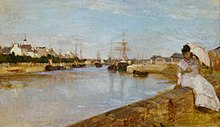

Maritime activities slowed at the start of the 19th century. Activity at the shipyards and naval base reached a low that would last until theJuly Monarchy.During this period, the city was more of an administrative center.[15]The firstsecondary schoolopened in 1822, alazarettoin 1823, andbarracksin 1839.[16]
The city began to modernize in the second quarter of the century; in 1825, a roofed slipway and adrydockwere added to the shipyards.[15]Asardinecannery[17]opened the same year. The firstgasworkswas built in 1845.[18]
In the second half of the 19th century, thesteam engineallowed the ports to strengthen their output.[16]The firstlocomotivereached the city in 1865.[17]In 1861, the originaldrydockwas enlarged as a second one was dug out. The same year, theironcladCouronnewas built on a design directly inspired by theGloireclass,though unlike her wooden-hull predecessors, she was entirely made of iron. She was followed in 1876 by the ironcladRedoutable,the first ship in the world with a steel structure.
In 1889, fishing expanded following the creation of the municipal fish market,[18]and the arrival ofsteam-poweredfishing trawlersin 1900. TheKeroman fishing portconstruction started in 1920.
World War II
[edit]In 1941, theGermans,thenoccupying France,chose to establish aU-boat baseat Lorient. Thesubmarinefacilities quickly became targets of constant bombing fromAlliedair forces. The Germans decided to build a complex of bomb-proofsubmarine pens,theirlargest U-boat base,which would house the2ndand the10thU-boat flotillas for the bulk of theBattle of the Atlantic.Karl Dönitz,thensupreme commander of the U-boat Arm,moved his staff into the Kernevel villa, just across the water from Keroman, inLarmor-Plage.
In 1943–1944, Lorient was nearly razed to the ground by Alliedbombing,which failed to destroy the submarine pens despite 4,000 tons of bombs dropped.[19]According to the bookSteel Boats, Iron Hearts(by formerU-505crewmanHans Goebeler), after the Allies failed to damage the U-boat bunkers the bombing shifted to the city itself to deny the Germans workers and other resources. Before the bombings, thousands of leaflets were dropped on the population instructing the inhabitants to evacuate.[20]Between 14 January 1943 and 17 February 1943, as many as 500 high-explosiveaerial bombsand more than 60,000incendiary bombswere dropped on Lorient.
After theNormandy landingsin June 1944 and thesubsequent breakout,Lorient was surrounded by Allied troops on 12 August 1944. Its usefulness as a naval base gone, Lorient was left in a state of siege, surrounded by theFrench Forces of the West,supported by a US Infantry Division. On 10 May 1945, theGerman garrisonsurrendered,two days afterthe official finalunconditional surrender of Germany.In 1949, the city of Lorient was awarded theLegion of Honourand theCroix de guerre 1939–1945.
Reconstruction
[edit]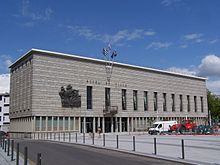
In April 1945, the Reconstruction Ministry advocated the use of temporary wooden shacks. These shelters were shipped as a kit to be built on site. In 1948, there were 28 settlements under the city's authority, and 20 more in theurban area,distributed among the neighboring towns ofPloemeur,Lanester,HennebontandQuéven.Each of these neighbourhoods could hold up to 280 houses.
This temporary housing would stand from 10 to 40 years depending on the location. The last shack in the largest settlement, Soye, was torn down in 1991. Today, only a few buildings dating to the 18th century still stand.
Geography
[edit]Location
[edit]
Lorient is located on the south coast ofBrittany,where the riversScorffandBlavetjoin to form theroadstead of Lorient,before discharging into theAtlantic Ocean.The river Ter used to flow into theestuaryto the south of the city, however, adamwas constructed in 1967, stopping the flow. The city is 503 kilometres (313 mi) south-west ofParis,153 kilometres (95 mi) south-west ofRennesand 158 kilometres (98 mi) north-west ofNantes.
The city comprises different neighbourhoods:
|
|
|
|
Adjacent towns:
Climate
[edit]Under theKöppen climate classification,Lorient experiences anoceanic climate(Cfb), with mild winters and cool to warm summers. Precipitation is evenly distributed throughout the year. Frost is rare in winter, as are days over 30 °C (86 °F) during summer.
| Climate data for Lorient (Lann-Bihoué Airport) 1991–2020 normals, extremes 1952–present | |||||||||||||
|---|---|---|---|---|---|---|---|---|---|---|---|---|---|
| Month | Jan | Feb | Mar | Apr | May | Jun | Jul | Aug | Sep | Oct | Nov | Dec | Year |
| Record high °C (°F) | 16.8 (62.2) |
18.4 (65.1) |
23.3 (73.9) |
27.1 (80.8) |
29.8 (85.6) |
35.9 (96.6) |
37.6 (99.7) |
37.5 (99.5) |
31.0 (87.8) |
27.2 (81.0) |
19.6 (67.3) |
16.4 (61.5) |
37.6 (99.7) |
| Mean maximum °C (°F) | 13.5 (56.3) |
14.2 (57.6) |
17.5 (63.5) |
21.3 (70.3) |
25.3 (77.5) |
28.9 (84.0) |
29.7 (85.5) |
29.1 (84.4) |
26.5 (79.7) |
21.0 (69.8) |
17.0 (62.6) |
13.9 (57.0) |
31.4 (88.5) |
| Mean daily maximum °C (°F) | 9.7 (49.5) |
10.4 (50.7) |
12.6 (54.7) |
15.0 (59.0) |
18.1 (64.6) |
20.8 (69.4) |
22.5 (72.5) |
22.6 (72.7) |
20.7 (69.3) |
16.8 (62.2) |
13.0 (55.4) |
10.4 (50.7) |
16.1 (60.9) |
| Daily mean °C (°F) | 6.9 (44.4) |
7.1 (44.8) |
8.8 (47.8) |
10.7 (51.3) |
13.7 (56.7) |
16.4 (61.5) |
18.0 (64.4) |
18.1 (64.6) |
16.1 (61.0) |
13.3 (55.9) |
9.8 (49.6) |
7.5 (45.5) |
12.2 (54.0) |
| Mean daily minimum °C (°F) | 4.0 (39.2) |
3.8 (38.8) |
5.0 (41.0) |
6.4 (43.5) |
9.3 (48.7) |
11.9 (53.4) |
13.6 (56.5) |
13.5 (56.3) |
11.5 (52.7) |
9.7 (49.5) |
6.6 (43.9) |
4.6 (40.3) |
8.3 (47.0) |
| Mean minimum °C (°F) | −3.5 (25.7) |
−2.7 (27.1) |
−1.0 (30.2) |
0.4 (32.7) |
3.5 (38.3) |
6.3 (43.3) |
8.9 (48.0) |
8.0 (46.4) |
6.0 (42.8) |
2.8 (37.0) |
−0.1 (31.8) |
−2.6 (27.3) |
−4.9 (23.2) |
| Record low °C (°F) | −13.1 (8.4) |
−11.0 (12.2) |
−7.4 (18.7) |
−4.1 (24.6) |
−1.1 (30.0) |
1.6 (34.9) |
3.4 (38.1) |
4.1 (39.4) |
1.0 (33.8) |
−1.8 (28.8) |
−5.0 (23.0) |
−8.7 (16.3) |
−13.1 (8.4) |
| Averageprecipitationmm (inches) | 109.0 (4.29) |
82.5 (3.25) |
66.2 (2.61) |
67.5 (2.66) |
66.0 (2.60) |
52.0 (2.05) |
55.2 (2.17) |
53.3 (2.10) |
65.7 (2.59) |
103.8 (4.09) |
107.6 (4.24) |
114.5 (4.51) |
943.3 (37.16) |
| Average precipitation days(≥ 1 mm) | 14.3 | 11.6 | 10.9 | 10.6 | 9.8 | 8.0 | 8.3 | 7.7 | 8.3 | 12.6 | 13.8 | 14.2 | 130.1 |
| Averagerelative humidity(%) | 88 | 85 | 82 | 79 | 81 | 80 | 80 | 81 | 84 | 87 | 87 | 88 | 83.5 |
| Mean monthlysunshine hours | 71 | 99 | 144 | 191 | 214 | 224 | 232 | 219 | 193 | 120 | 87 | 72 | 1,866 |
| Source: Météo France,[21]Infoclimat (humidity, 1961–1990),[22]and Meteociel[23] | |||||||||||||
Population
[edit]In 2017, Lorient had a population of 57,149.[24]In 2017, itsintercommunalityLorient Agglomérationhad 203,309 inhabitants.[25]Lorient is the most populouscommuneinMorbihandépartement,although thepréfectureis the slightly smaller commune ofVannes.Inhabitants of Lorient are calledLorientais.
The population data in the table and graph below refer to the commune of Lorient proper, in its geography at the given years. The commune of Lorient absorbed the former commune of Keryado in 1947.[26]
|
|
| |||||||||||||||||||||||||||||||||||||||||||||||||||||||||||||||||||||||||||||||||||||||||||||||||||||||||||||||||||||
| |||||||||||||||||||||||||||||||||||||||||||||||||||||||||||||||||||||||||||||||||||||||||||||||||||||||||||||||||||||||
| Source: EHESS[26]and INSEE[24] | |||||||||||||||||||||||||||||||||||||||||||||||||||||||||||||||||||||||||||||||||||||||||||||||||||||||||||||||||||||||
Breton language
[edit]The municipality launched a linguistic plan throughYa d'ar brezhonegon 25 January 2007.
In 2008, 2.71% of the children attended the bilingual schools in primary education.[27]
Economy
[edit]
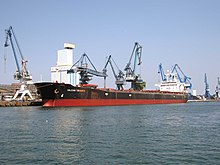
Ports
[edit]Lorient is commonly referred to asLa ville aux cinq ports( "the city of five ports" ): military, fishing, commercial, passengers and yachting.[28]In 2010, the sector represented 9,600 direct jobs for a total 12,000 jobs (with indirect jobs accounted for), or 12% of local employment.[29]
- Keroman fishing port (fr): In 2010, with a catch of 27,000 tons, it was second only toBoulogne-sur-Merregarding catch tonnage among French fishing ports, but first considering the cash value.[30]It accounts for 3,000 jobs (including 700 fishermen) and 130 fishing vessels.
- Kergroise cargo port:With 2.6 million tons of cargo per year (including oil, cattle fodder, sand, containers), it ranks first in Brittany.[31]
- Marinas:mooring berths are dispatched on Lorient (370), Kernevel (1,000),Port-Louis(450),Gâvres(57) andGuidel(102).[32]Additionally, there is an 800 metres (2,600 ft) long dock dedicated to offshore competitive sailing (Pôle course au large), recently built within theformer submarine base.
- Passenger ships: each year, more 457,500 passengers set sail to the nearby islands ofGroixandBelle-Île-en-Mer.
- Military: though no longer aFrench Navybase, newwarshipsare still built atDCNS,docking temporarily onwharvesalong theScorffriver.

Industry
[edit]From its founding,shipbuildinghas always been of great importance to the city.DCNScontinues the legacy of the formerly state-ownedshipyards(colloquially known asl'Arsenal) that began operation in 1690. It still builds warships, mainlyfrigates.There is also a substantial industrial base in Keroman to support the fishing fleet.
Transport
[edit]Lorient South Brittany Airportis situated just west of the city at Lann Bihoue. It operates charter flights and regular flights to Toulouse. It used to operate direct flights toParisandLyonall year long and other city such as London and Porto in the Summer.
TheGare de Lorientis the railway station, offering connections to Quimper, Nantes, Rennes, Paris (less than three hours by TGV) and several regional destinations.
Education
[edit]Schools in Lorient belong to the Academy ofRennes.
Tertiary
[edit]- CPGEatDupuy-de-LômeandSaint Joseph-La sallelycées.
- Université de Bretagne Sud.[33]
- Institut universitaire de technologie de Lorient
- École nationale supérieure d'ingénieurs de Bretagne Sud[34]
- École supérieure d'art.[35]
- École nationale de musique et de danse.[36]
Military
[edit]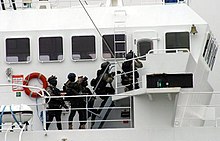
Active units based near Lorient:
- Naval Commandos(Commando Marine): thespecial forcesof theFrench Navy.Accordingly, it is one of the most selective units among theFrench armed forces,equivalent in their mission and affiliation toNavy SEALsor BritishSpecial Boat Service.Five out of the six existing naval commandos[37]are based inLanester,just across theScorffriver from Lorient. The Naval Fusilier & Commando Training School is also based here.
- Lann-BihouéNaval Aviation Base:Five squadrons ( "flottilles") are based inPloemeur.Their tasks includeairborne early warning,maritime patrolandair-sea rescue.
Lorient Submarine Base
[edit]
Lorient was the location of an extensivesubmarine base,built bythe GermansinWorld War IIand used subsequently by theFrench Navy.Head of the U-Boat ArmKarl Dönitzdecided to construct the base on 28 June 1940. Between November 1940 and January 1942 a number of gigantic reinforced concrete structures were built. including three on the Keroman peninsula. They are called K1, K2 and K3. In 1944 work began on a fourth structure. The base was capable of sheltering thirty submarines. Lorient was damaged by Allied bombing raids but the naval base survived the war. Following the German surrender the base was used by the French Navy, named forJacques Stosskopf,a hero of theFrench Resistancewho had worked there. The base was decommissioned in 1995 and turned over to civilian use.
Culture
[edit]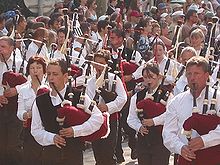
Events
[edit]Each year in August since 1970, Lorient hosts theFestival interceltique,bringing together artists from all theCeltic world(Brittany,Cornwall,Scotland,Ireland,Wales,Galicia,Asturias,Australia,AcadiaandIsle of Man). Each year, a Celtic nation is chosen as honored guest. It is one of the biggest festivals in Europe by attendance (800,000 people for the 40th edition[38])
Media
[edit]Lorient is home toTébéSud(formerly TyTélé), a local TV channel covering Morbihan throughDTT.
Religion
[edit]Catholic churches are among the main religious landmarks of Lorient. While theChurch of Our Lady of the Assumptionwas built in 1850 in a revivalist neo-Gothic style, the church of Saint Joan of Arc was built in a neo-Roman style in the 1930s by French architectJean Desboisand a few years later in 1955, and the modernist church ofNotre-Dame-de-Victoireis the highest point of Lorient with its 4-meter-high concrete bell tower though the population never really accepted this new style.[39]Major Catholic festivals such as Christmas, Carnaval, Easter and thePardonare celebrated as major feasts of the city.
Sports
[edit]Football
[edit]The most popular club in Lorient isFC Lorient,which currently play inLigue 1,after winningLigue 2in 2020. They are nicknamedles Merlus.They play their home fixtures atStade du Moustoir.Christian Gourcuffhas managed the team for over 20 years (aggregate years).
Sailing
[edit]The convertedsubmarine basehas been home port to several skippers and their sailing teams:
- Jérémie Beyou[40](Delta Dore),
- Pascal Bidégorry[40](Banque Populaire),
- Franck Cammas[40](Groupama), winner of the2011–12 Volvo Ocean Race
- Samantha Davies[40](Roxy),
- Jean-Baptiste Dejeanty[40](Maisonneuve),
- Jean-Pierre Dick[40](Paprec-Virbac),
- Yann Elies[40](Generali),
- Alain Gautier[40](Foncia),
- Sébastien Josse[40](British Telecom),
- Marc Thiercelin[40](DCNS)
Lorient was also a staging port during the2011–12 Volvo Ocean Race,as well as the starting point oflaSolitaire du Figaro(2009 edition).
Eric Tabarlybuilt three out of his sixPen Duickboats in Lorient.[41]
NotableLorientais
[edit]Arts and literature
[edit]- Marie-Léontine Bordes-Pène(1858–1924), pianist
- Charles Delioux(1825–1915), composer and pianist
- Marie Dorval(1798–1849), actress
- Irène Frain(b. 1950), writer
- Ernest Hello(1828-1885), writer
- Viktor Lazlo(b. 1960), singer
- Rita Strohl(1865–1941), pianist and composer
- Jacques Vaché(1895–1919), writer and artist
Sailors
[edit]- Jean-Baptiste Bompard(1757–1842), took part in theAmerican Revolutionary Waras aprivateer,later rose to the rank ofadmiral.
- François Joseph Bouvet(1753–1832),vice admiralandmaritime prefect
- Jean-Baptiste Chaigneau(1769–1832), sailor, FrenchconsulinCochinchina
- Pierre-François Forissier,b. 1951, admiral,Chief of Staff of the French Navy(2008–2011)
- Raymond Rallier du Baty(1881–1978),explorerof theKerguelen islands.
Politics
[edit]- Henri Dupuy de Lôme(1816–1885),naval architect,chief designer of theNapoléon,La GloireandGymnote,which were breakthroughs in naval technology, also designedairships,deputyrepresentingMorbihan,member of theAcademy of Sciences,senator for life.
- Pierre-Paul Guieysse(1841–1914), Morbihan deputy, Minister of the Colonies.
- Jean-Yves Le Drian,b. 1947, former mayor of Lorient, former Morbihan deputy, formerMinister of Defence,former Secretary of State.
- Jules Simon(1814–1896),philosopher,President of the Council of Ministers,senator for life, member ofl'Académie française.
Sports
[edit]- Georges Eo,b. 1948, formerfootballplayer and manager
- Christian Gourcuff,b. 1955, former manager ofFC Lorient
- Yoann Gourcuff,b. 1986, son of the former,internationalmidfielder, currently plays forStade Rennais F.C.
- Ronan Le Crom,b. 1974, goalkeeper
- Jérémy Morel,b. 1984, left-back forOlympique de Marseille
- Illan Meslier,b. 2000, goalkeeper forLeeds United
Sciences
[edit]- Pierre Fatou(1878–1929), mathematician and astronomer
- Nicole Le Douarin,b. 1930, biologist
Others
[edit]- Jacques Andrieux(1917–2005), WWII fighter ace andCompagnon de la Libération.
- Élisabeth Le Port(1919-1943) WWII French Resistance member.
- Jacques Stosskopf(1898–1944), naval engineer,résistant.Mistaken for being a traitor, in 1946 the submarine base was renamed "Base Ingénieur Général Stosskopf" in his honour.
International relations
[edit] Galway,Ireland
Galway,Ireland Vigo,Spain
Vigo,Spain Wirral,England, United Kingdom
Wirral,England, United Kingdom Ventspils,Latvia
Ventspils,Latvia Ludwigshafen,Germany
Ludwigshafen,Germany České Budějovice,Czech Republic
České Budějovice,Czech Republic Denizli,Turkey
Denizli,Turkey
See also
[edit]- Mississippi Company
- FC Lorient
- Festival Interceltique de Lorient
- Arrondissement of Lorient
- Communes of the Morbihan department
- Raid on Lorient(1746)
- History of Lorient
- Gabriel Hotel
- Fishing port of Lorient-Keroman
References
[edit]- Notes
- ^"Maires du Morbihan"(PDF).Préfecture du Morbihan. 7 July 2020.
- ^"Populations légales 2021"(in French).The National Institute of Statistics and Economic Studies.28 December 2023.
- ^Chaumeil, Louis (1939). "Abrégé d'histoire de Lorient de la fondation (1666) à nos jours (1939)".Annales de Bretagne et des Pays de l'Ouest(in French).46(1): 66–87.doi:10.3406/abpo.1939.1788.
- ^Chaumeil, Louis (1939). "Abrégé d'histoire de Lorient de la fondation (1666) à nos jours (1939)".Annales de Bretagne et des Pays de l'Ouest(in French).46(1): 67.doi:10.3406/abpo.1939.1788.
- ^abChaumeil, Louis (1939). "Abrégé d'histoire de Lorient de la fondation (1666) à nos jours (1939)".Annales de Bretagne et des Pays de l'Ouest(in French).46(1): 68.doi:10.3406/abpo.1939.1788.
- ^"L'Origine du nom de Lorient".11 September 2012.
- ^Chaumeil, Louis (1939). "Abrégé d'histoire de Lorient de la fondation (1666) à nos jours (1939)".Annales de Bretagne et des Pays de l'Ouest(in French).46(1): 69.doi:10.3406/abpo.1939.1788.
- ^abChaumeil, Louis (1939). "Abrégé d'histoire de Lorient de la fondation (1666) à nos jours (1939)".Annales de Bretagne et des Pays de l'Ouest(in French).46(1): 70.doi:10.3406/abpo.1939.1788.
- ^René Estienne,« Les archives des compagnies commerciales et la traite: l'exemple de la Compagnie des Indes »,Service historique de la Défense, Lorient, janvier 2009
- ^abChaumeil, Louis (1939). "Abrégé d'histoire de Lorient de la fondation (1666) à nos jours (1939)".Annales de Bretagne et des Pays de l'Ouest(in French).46(1): 71.doi:10.3406/abpo.1939.1788.
- ^abChaumeil, Louis (1939). "Abrégé d'histoire de Lorient de la fondation (1666) à nos jours (1939)".Annales de Bretagne et des Pays de l'Ouest(in French).46(1): 73.doi:10.3406/abpo.1939.1788.
- ^Chaumeil, Louis (1939). "Abrégé d'histoire de Lorient de la fondation (1666) à nos jours (1939)".Annales de Bretagne et des Pays de l'Ouest(in French).46(1): 72.doi:10.3406/abpo.1939.1788.
- ^abChaumeil, Louis (1939). "Abrégé d'histoire de Lorient de la fondation (1666) à nos jours (1939)".Annales de Bretagne et des Pays de l'Ouest(in French).46(1): 74.doi:10.3406/abpo.1939.1788.
- ^Chaumeil, Louis (1939). "Abrégé d'histoire de Lorient de la fondation (1666) à nos jours (1939)".Annales de Bretagne et des Pays de l'Ouest(in French).46(1): 75.doi:10.3406/abpo.1939.1788.
- ^abChaumeil, Louis (1939). "Abrégé d'histoire de Lorient de la fondation (1666) à nos jours (1939)".Annales de Bretagne et des Pays de l'Ouest(in French).46(1): 76.doi:10.3406/abpo.1939.1788.
- ^abChaumeil, Louis (1939). "Abrégé d'histoire de Lorient de la fondation (1666) à nos jours (1939)".Annales de Bretagne et des Pays de l'Ouest(in French).46(1): 77.doi:10.3406/abpo.1939.1788.
- ^abChaumeil, Louis (1939). "Abrégé d'histoire de Lorient de la fondation (1666) à nos jours (1939)".Annales de Bretagne et des Pays de l'Ouest(in French).46(1): 80.doi:10.3406/abpo.1939.1788.
- ^abChaumeil, Louis (1939). "Abrégé d'histoire de Lorient de la fondation (1666) à nos jours (1939)".Annales de Bretagne et des Pays de l'Ouest(in French).46(1): 79.doi:10.3406/abpo.1939.1788.
- ^Lagarrigue, Max (2007)."Comment les Français vivent-ils les bombardements alliés?".Arkheia.Archived fromthe originalon 3 July 2013.Retrieved21 March2013.
- ^Hans, Goebeler (2008).Steel Boats, Iron Hearts.Savas Beatie LLC.
- ^"Données climatiques de la station de Lorient"(PDF)(in French). Météo France.Archived(PDF)from the original on 9 July 2021.Retrieved9 September2023.
- ^"Normes et records 1961-1990: Lorient-Lann Bihoué (56) - altitude 42m"(in French). Infoclimat.Retrieved30 December2015.
- ^"Normales et records pour Lorient-Lann Bihoue (56)".Meteociel.Retrieved14 September2020.
- ^abPopulation en historique depuis 1968,INSEE
- ^"Comparateur de territoire, Intercommunalité-Métropole de CA Lorient Agglomération (200042174)".INSEE.Retrieved2 September2020.
- ^abDes villages de Cassini aux communes d'aujourd'hui:Commune data sheet Lorient,EHESS(in French).
- ^(in French)Ofis ar Brezhoneg:Enseignement bilingue
- ^"Lorient-ports".Archived fromthe originalon 9 October 2013.Retrieved11 March2013.
- ^Josse, Charles (25 March 2011)."Lorient: Actualités et infos en direct, sorties, agenda, images, 56100 - Ouest-France".Ouest-France.Retrieved11 March2013.
- ^"26 000 tonnes de poisson au port de pêche de Lorient".Ouest-France.7 January 2011.Retrieved11 March2013.
- ^"Lorient - Ports".Archived fromthe originalon 11 January 2012.Retrieved11 March2013.
- ^"Ports - Pays de Lorient".Retrieved11 March2013.
- ^"Tout savoir sur la vie des campus".univ-ubs.fr.6 April 2023.
- ^"Accueil du site de l'ENSIBS - Université Bretagne Sud".www-ensibs.univ-ubs.fr.3 May 2021.
- ^"École Supérieure d'Art".Archived fromthe originalon 4 March 2013.Retrieved27 March2013.
- ^École Nationale de Musique et de DanseArchived12 March 2009 at theWayback Machine
- ^In the French Navy nomenclature, commandos are understood as units, not individuals
- ^"Record d'affluence au Festival interceltique de Lorient".Le Monde.16 August 2010.Retrieved25 March2013.
- ^Leniaud, Jean-Michel (2005).Entre nostalgie et utopie: réalités architecturales et artistiques aux XIXe et XXe siècles(in French). Librairie Droz. p. 115.ISBN978-2-900791-77-6.
- ^abcdefghij"Voile news".Retrieved25 March2013.
- ^"Cité de la voile".Retrieved25 March2013.
- ^"Jumelages".lorient.bzh(in French). Lorient.Retrieved17 November2019.
External links
[edit]- Official website(in French)
- Ville de Lorient et Festival Interceltique ImagesArchived12 November 2018 at theWayback Machine
- Keroman submarine base
- Festival Interceltique de Lorient
- Base Mérimée:Search for heritage in the commune,Ministère français de la Culture.(in French)
- See pictures on Antonio Mucherino's web siteArchived3 March 2012 at theWayback Machine
- Tourism office(in French)





